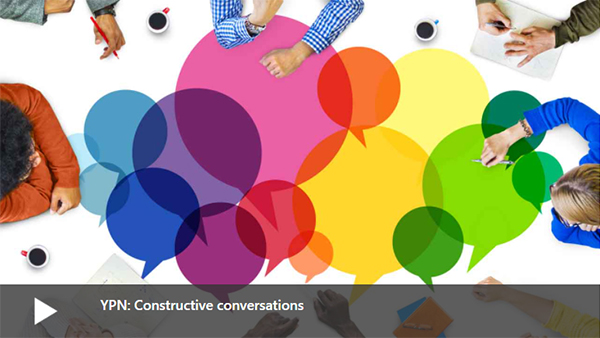A key challenge for many organisations is how to create diverse and inclusive team environments in which each participant feels safe to express their opinion. Speaking up is often viewed as a risk, but failing to do so can have disastrous consequences. A recent webinar for the CISI’s Young Professionals' Network (YPN), hosted by YPN chair Emma Dobson MCSI and featuring international guest speaker and coach Tom Flatau, addresses this challenge by exploring how to achieve productive dialogue about difficult or challenging subjects and circumstances.
The webinar looks at the power dynamics of teams, and how individuals can learn to strike a balance between articulating their thoughts with confidence and having those thoughts and their opinions challenged constructively.
It outlines:
- How to create an environment where it’s safe to speak up and disagree
- How to understand the difference between healthy and unhealthy conflict
- How to become comfortable being uncomfortable
- Various communication paradoxes, such as being frank and diplomatic, being confident yet open to different perspectives

Easy vs difficult conversations
Tom shows the audience a short clip of geometric shapes moving around a screen and into and out of a box and asks for their interpretation of what’s happening. He uses the varied answers he receives to make the point that we’re always looking for meaning in what we see, hear and experience, even though, in this case, “the shapes mean nothing”, he says.
Our colleagues will always construe some sort of meaning from our actions, he says, which is why the way we communicate and conduct ourselves in the workplace is so important.
Tom says that people often interpret things they don’t understand in a negative way, therefore it’s much easier to have constructive conversations about easier issues, which generate productive ideas and good teamwork, than more difficult ones.
“However, sometimes, when we get to tough issues, they’re undiscussable. Emotions take over, and we can become too scared to bring things up. We can even get into attack-defend mode. In short, there’s no real teamwork present.”
Homogenous teams think they do better than diverse teams but are less productive Using two types of team structures – one homogenous, one more diverse – as examples, Tom outlines why diverse teams are better at having difficult discussions than homogenous ones. He suggests that because the likelihood of conflict arising in more diverse teams is greater because of the difference in backgrounds and cultures, the likelihood of conflict resolution (and, as a result, constructive solutions) emerging is also greater.
By contrast, homogenous teams with similar viewpoints are less likely to have difficult discussions and to tackle more difficult issues. Because of the lack of conflict and increased consensus, “homogenous teams may feel they’re doing a lot better than diverse teams,” but their performance is in fact worse, says Tom, sharing charts that show diverse teams doing “way better than homogenous teams because they have to work harder, there’s less groupthink (people need to speak up), and there’s more social intelligence.”
Another danger to be aware of, says Tom, is ‘homophily’ – the tendency for people to seek out or be attracted to those who are similar to themselves. In teams, people may “pile in behind those with the dominant opinion”. But if that person leaves or is fired, the team is poorer for it, he says.
Managing diverse teams
“Diversity is having a seat at the table, whereas inclusion is having a voice at the table,” Tom says. “This means that it’s no good having diversity in your team if there’s no inclusion.”
Tom provides his tips for encouraging inclusion in diverse teams:
- If you’re a team leader, give your opinion last. Avoid ‘team leader privilege’, which includes leaders thinking they have licence to speak first. If you do speak first, you will have an impact on everyone else’s opinion.
- Ensure everyone is listened to, especially the quiet ones. Proactively ask for contributions from the quieter members of the team.
- Beware of hybrid meetings – if one person is virtual, everyone is virtual.
- Beware of having favourites and avoid “in-group/out-group bias”.
He discusses Google’s research into team effectiveness from 2016, which finds that the primary factor separating the company’s best most successful teams from just average teams is ‘psychological safety’. According to Tom, this is when “team members feel safe to take risks and be vulnerable in front of each other”. Drawing on an example from an audience member, a mother who says she wants to go home after work to be with her children, Tom and Emma agree that psychological safety includes feeling safe enough to say no to invitations to after work drinks, for example, without worrying about negative reactions from team members.
“The job of the team leader should be to create this safe environment,” says Tom.
Increasing conversational capacity
Tom talks about the powerful role our emotions can play in determining our actions, and why mastering them is so important for becoming an effective team player. He says that emotions can make you ‘freeze’ so you don’t speak up when you should, they can make you ‘flee’ from a challenge instead of confronting it, and they can make you ‘fight’ – arguing to win instead of listening to understand. He urges the audience to think about triggers for any of the above situations.
He shares his four key tips for increasing ‘conversational capacity’ while working in a team:
- State your position with intent – be succinct, specific and generous
- Explain your underlying thinking – clarify how you reached your opinion
- Test your perspective – imagine it’s a hypothesis that needs testing
- Enquire into the perspectives of others – ask them to give you examples
Tom concludes the webinar by going into specific examples.
View the entire event to gain insight from the extra context and detail and achieve 60 mins CPD.